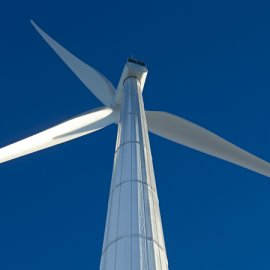The Virtual Power of Innovation
-
English
-
ListenPause
[Intro music] Welcome to World Ocean Radio… I’m Peter Neill, Director of the World Ocean Observatory. One way to look at the history of technology is to see it as a survey of evolving efficiency – the continuing search through invention and management to aggregate functionality and delivery of its effects as efficiently as possible. Devices, and today more often the operating systems inside those devices, are considered to be ever expanding, useful tools in the delivery of faster results in time and space; short-cut technologies are a primary obsession of venture capitalists in their search for the next little, albeit efficient, thing that will explode as the next big thing in our techno-world. The delivery of energy is a consummate case in point. From a single homesteader cutting firewood or plowing a row, we have progressed to massive generation powered by fossil fuels and distributed by national, even international grids that deliver energy to burgeoning population and industrial agriculture and manufacturing that now meet our need to consume, build, and thrive. Under-developed communities look for this scale of energy to provide and progress from poverty to prosperity and stability. Developed communities continue to cleave to unlimited growth and demand more and more energy from less and less available conventional sources. This operating system demand, then, requires exponential additional supply, even if it leads to conflict, war, and other unforeseen negative consequence to meet the collective need worldwide. This would seem to describe the situation we face today when our old generating systems decline and pollute, our old plants and grid cannot maintain adequate delivery, and our natural resource supplies peak and dissipate to the point of collapse. Technology has responded however through new, more efficient systems, less reliant on unsustainable supply – the opportunities of hydro, wind, solar, and geo-thermal power that can produce more, cost less, and be distributed more effectively, efficiently, and sustainably to fulfill societal need in a world that is bigger, and smaller, as its population grows. We are all aware of these alternative energy technologies. We see the ever-increasing number of wind and solar farms, often in surprising places. We see the statistics that indicate that more and more nations and communities are abandoning more expensive and polluting coal production, oil and fracking consumption, and even nuclear generation that decades ago was the great hope for our clean energy future, save for the pesky question of what to do with its toxic radioactive residue. How do we maximize these new efficiencies to even great effect? Statkraft, the Norwegian energy conglomerate, has begun to implement in Germany and other European locations a new digital market access platform intended to assess the variables of weather, consumer demand, price volatility, disconnected markets, large and small generation sources, and decentralized storage into a single system that allows for independent control of the distribution of power through an integrated, smarter grid to an ever-changing reality of supply and demand. For example, in Germany, Statkraft has created what it calls a “virtual power plant,” the first of its kind that unites production of over 1300 wind farms, 100 solar power producers, 12 biomass power plants, and 8 hydropower projects to centralize the distribution of more than 10,000 megawatts, roughly equivalent to 10 nuclear reactors. The company is currently rolling out similar projects in the United Kingdom, France, and Turkey. Other companies in other regions are following suit. Shortcuts, the reduction of energy required to delivery energy, the affirmation of greater efficiency as a desirable and profitable enhancement of greater efficiency, the application of existing technology to amalgamate and amplify the productivity of existing technology – these are simplifying and sustainable solutions that demonstrate the power of invention and innovation. Such ideas, applied, freed from the inhibition and sabotage of vested, unchanging interests, are the pathways to change and the future. Ocean generated energy is yet to be technologically achieved at scale, but when it comes such systems of distribution will be essential to the success of what will surely be the most dynamic and sustainable energy system on earth. We will discuss these issues, and more, in future additions of World Ocean Radio. [outro music]
Invention and management of energy systems have led to increased efficiency and less reliance on unsustainable supplies of fossil fuels. In this episode of World Ocean Radio we discuss Statkraft, a Norwegian energy conglomerate that has begun to implement digital market platforms and smarter grid technology to help build more dynamic, efficient and sustainable energy systems worldwide.
Do you prefer the written word? Head on over to Medium.com/@TheW2O.
About World Ocean Radio
World Ocean Radio is a weekly series of five-minute audio essays available for syndicated use at no cost by college and community radio stations worldwide. Peter Neill, Director of the World Ocean Observatory and host of World Ocean Radio, provides coverage of a broad spectrum of ocean issues from science and education to advocacy and exemplary projects.
Image Credit
Nicholas Doherty
Resources from This Episode
Statkraft Virtual Power Plant, Explained
- Login to post comments



